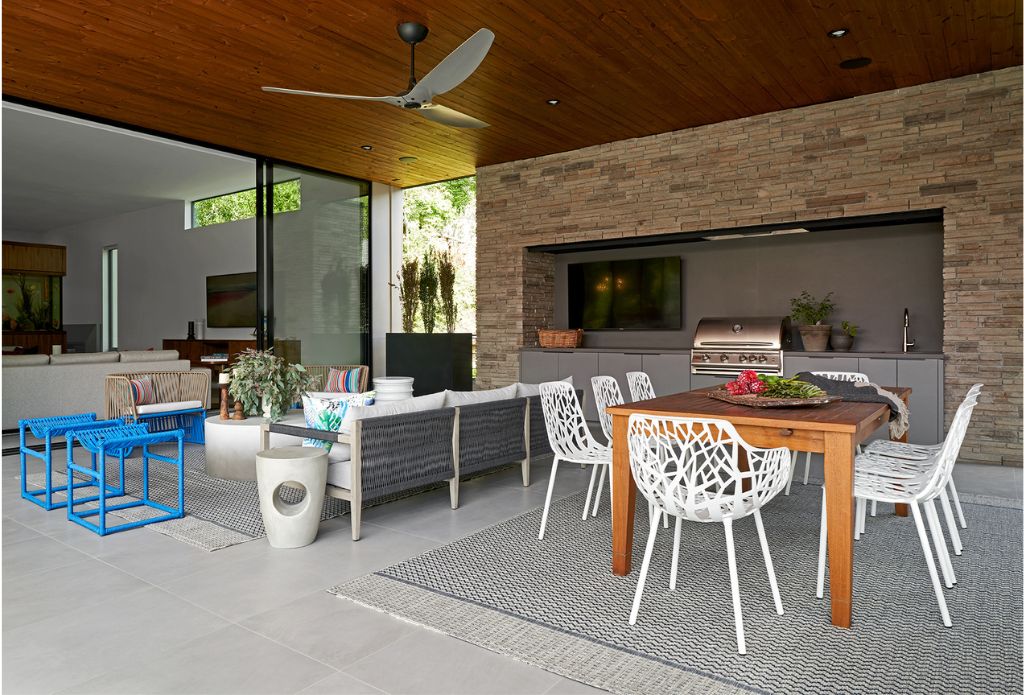After the COVID-19 pandemic and several lockdowns, homeowners simply do not take their outdoor living space for granted. This year’s interior design and home renovation trends both demonstrate how functional outdoor living spaces have become a major focal point for homeowners. Outdoor living spaces make homes more enjoyable for the owners. They also make our homes more suitable for entertaining guests. A thoughtfully designed outdoor space can seamlessly extend your home’s interior. That way, you can entertain everyone from colleagues to close friends to kids’ playmates. Plus, outdoor living spaces make our homes more marketable to future buyers. To get your outdoor space in tip-top shape for this year’s entertaining seasons, read our decorator’s guide to designing outdoors! From repurposing indoor furniture to embracing the history of your home, we offer eleven of our favorite outdoor design ideas for entertaining all year.
The Interminable Reign of Indoor-Outdoor Living
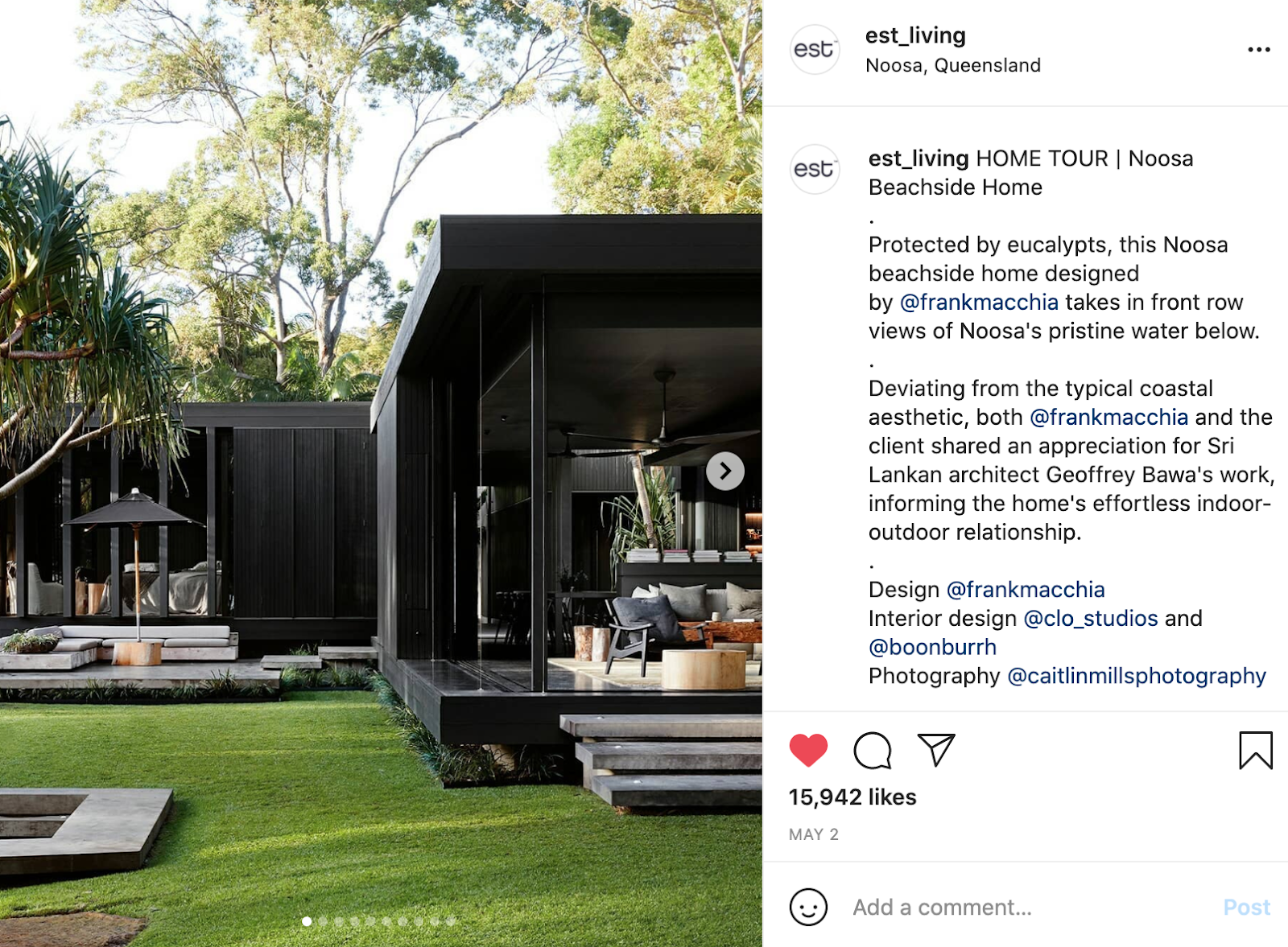
Over the last few years, outdoor spaces like patios, balconies and backyards have evolved into true living spaces. Outdoor spaces once functioned solely as spots for morning coffee and destinations for weekend pool parties.
From open-air dining rooms to pool houses that double as accommodations for overnight guests, today’s outdoor spaces are extensions of our homes. As such, it makes sense that this year’s biggest interior design trends focus heavily on seamless indoor-outdoor living.
Regina Cole said it best in her article “Outdoor Living Space” for Forbes. Cole wrote that today’s homeowners “don’t just want to walk to the park.” Instead, we “want to cook, relax, gather with friends and family, exercise and…even work outdoors.” Most of all, Cole notes that “we want that outdoor space to be part of our home.”
Treating Outdoor Spaces as Extensions of the Home
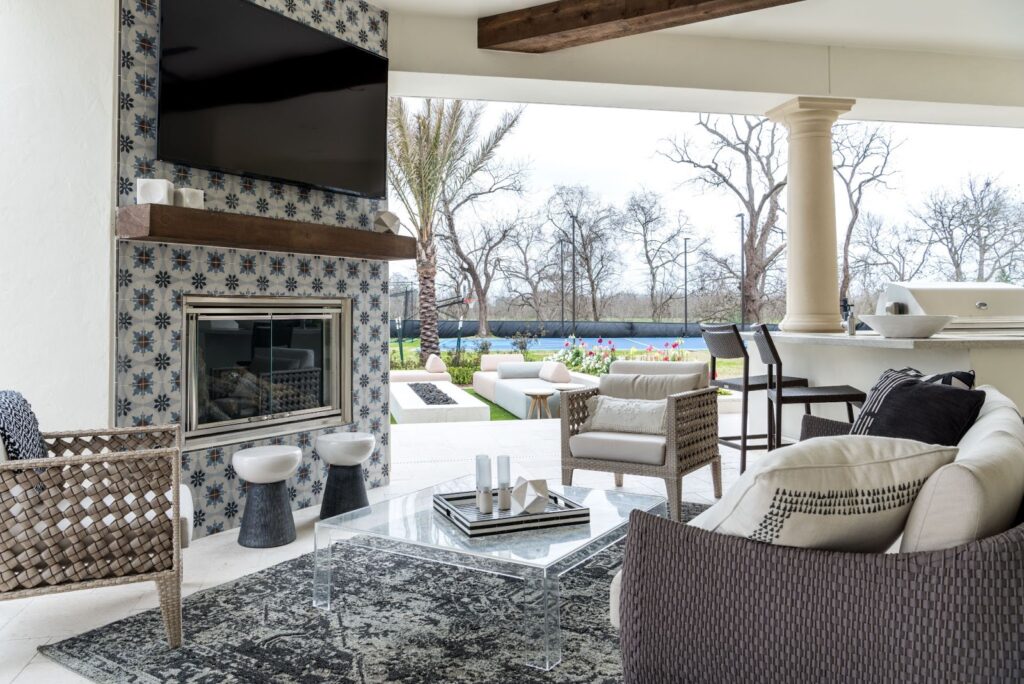
Outdoor design offers a certain level of childlike joy and a few additional playful prints. When outdoor spaces connect to a home’s interior, they must also reflect the aesthetic of the main house.
Decorators, designers and homeowners agree that outdoor entertaining spaces should be comfortable, functional and reflective of the homeowner’s personality and aesthetic. In short, they must be addressed as “outdoor rooms” rather than as separate entities — completely divorced from your home.
What you, your family and your guests get out of your outdoor entertaining space depends upon how you design it. It also depends on how well the space meshes with the lifestyle lived within your house.
In his article “How to Create an Outdoor Room” for The NY Times, Tim McKeough recommends homeowners address necessities before delving into the aesthetics. McKeough writes that “if you want an outdoor space where you’ll be comfortable lingering for hours…you need to address some basic questions.”
These questions include “‘Can you be protected from the sun? Can you put a drink down? Can you put your feet up?’” In short — questions McKeough — “you need to think of it as another room in your home — an outdoor room” and furnish as such.
11 Outdoor Design Ideas for Entertaining All Year Round
#1 Consider Outdoor Spaces When Designing from the Ground Up
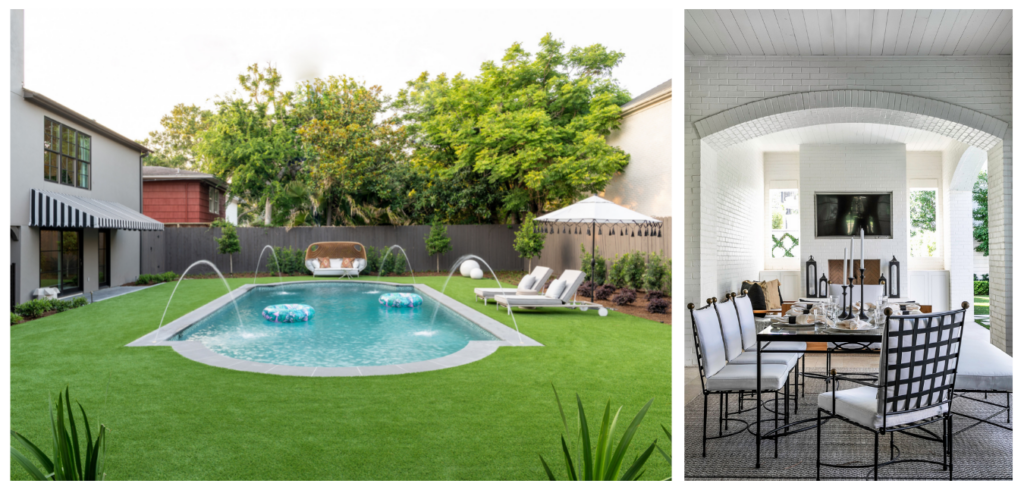
First on our list of outdoor design ideas for entertaining all year is to think about your backyard when designing your new custom home. One of the first spots we think to renovate when selling our homes is the backyard or the front patio.
After all, front yard curb appeal and backyard green spaces represent two major selling points. According to this article from REALTOR Magazine, “homes with high curb appeal tend to sell for an average of 7% more than similar houses.”
However, few consider the landscaping and functionality of their outdoor spaces when building a home from the ground up. Homeowners should never leave outdoor entertaining spaces as an afterthought. Instead, they should work with a residential design firm to ensure all landscaping — both soft and hard elements — mesh with the home itself.
#2 Create Spaces Everyone Can Use — Every Day of the Year
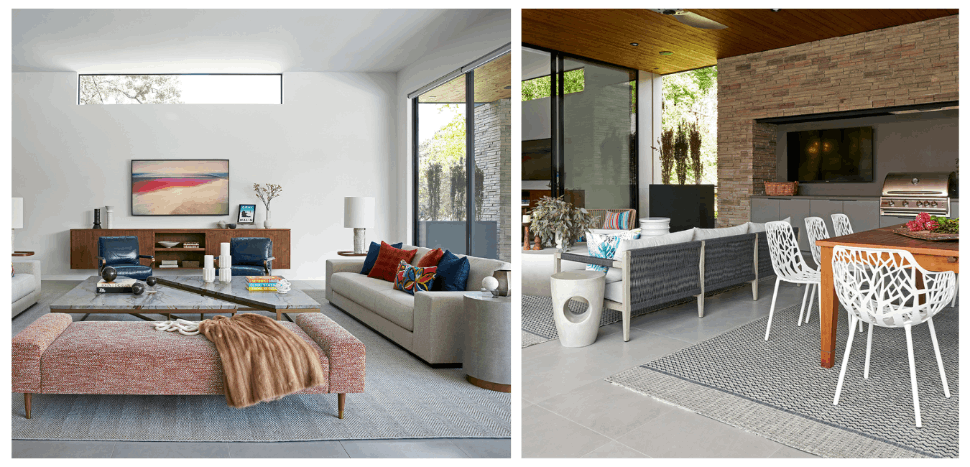
Second on our list of outdoor design ideas for entertaining is to create spaces everyone can use — every day of the year! Consider the scale of architectural details, ensure outdoor spaces connect to the interior and plant a garden that looks beautiful all year. In “7 Steps to Creating a Backyard from Scratch” for This Old House, Kathryn Keller explains how to approach each step.
Improve Indoor-Outdoor Flow
First, homeowners should consider how guests and residents will flow from indoor spaces into outdoor spaces. This refers back to the idea that the backyard is an extension of the home. In our recent Braeswood Place project, we added floor-to-ceiling sliding glass doors to connect the living room to the outdoor patio. Pictured above, the covered patio boasts an outdoor kitchen, dining room and cozy seating area that can be used all year.
Focus on Size and Scale
Next, homeowners should establish the proper proportions for their outdoor space. Quoting landscape architect Paul Maue, Keller notes that “’getting the scale right is the hardest thing—you always need more space than you think.’” The design team at LUDC carefully considered scale when designing a backyard patio with loggia for our Hedwig Village clients. This cozy space expands our clients’ indoor space with a sitting area, outdoor kitchen, pool washroom and outdoor shower. Learn more about our Hedwig Village project here.
Landscape for All Seasons
Third, homeowners should create a garden that welcomes visitors in all seasons. Keller writes that “most gardens are loaded with blossoms in spring and early summer.” This makes sense, as the summer “is when the majority of flowering perennials, shrubs, and trees bloom.” However, “with a little careful planning, though, there can be something in a garden to delight the senses at every time of the year.” We will elaborate on this in the eighth of our outdoor design ideas.
Make Sure All Guests Are Accounted For
Lastly, homeowners should design outdoor spaces with all visitors and residents in mind — from elderly parents to toddler-age children. Create a “quiet destination” for pensive friends with a bench nestled between trees. Craft a children’s play area with a minimalistic bocce ball court or chic croquet pad.
#3 Consider Alternative Functions for Traditional Spaces
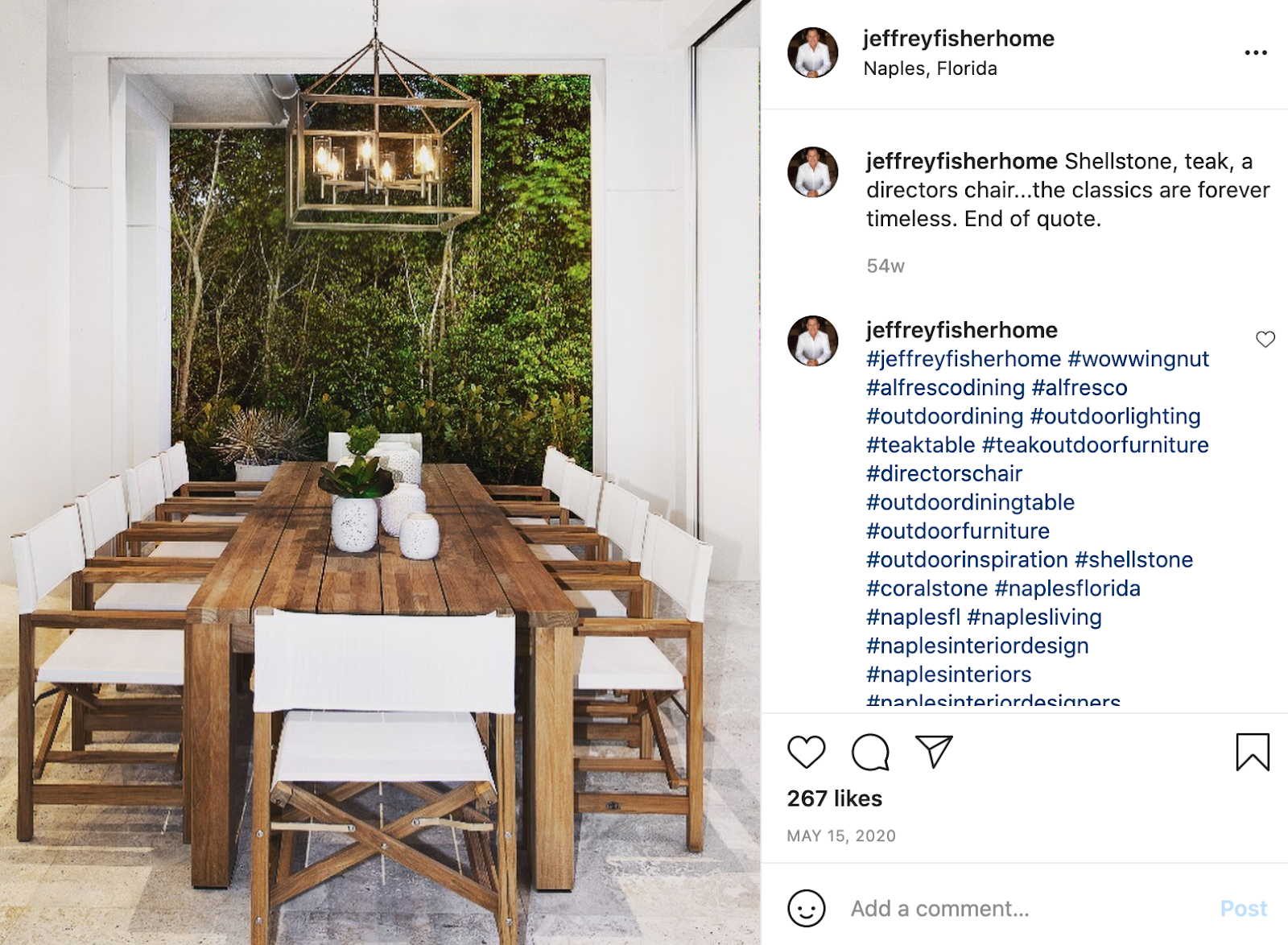
Third on our list of tips for designing outdoors is to think outside the box. If you purchased a home from a previous owner, remember that traditional functions need not be maintained. While it is important to honor the aesthetics and original elements of a historic home, spaces can easily be transformed for modern-day living.
One of our outdoor design ideas is extending your formal dining room. Rather than opting for a causal outdoor dining set made from wicker or aluminum, consider an elaborately dressed formal dining table. We love this ten seat set from @jeffreyfisherhome on Instagram.
Another of our favorite tips for transforming a backyard is to embrace unconventional uses for traditional spaces. For instance, consider transitioning your pool house to an indoor-outdoor office — as we suggested in our recent post “Home Spaces Designed for Remote Work.”
#4 Reuse and Refinish Wherever Possible
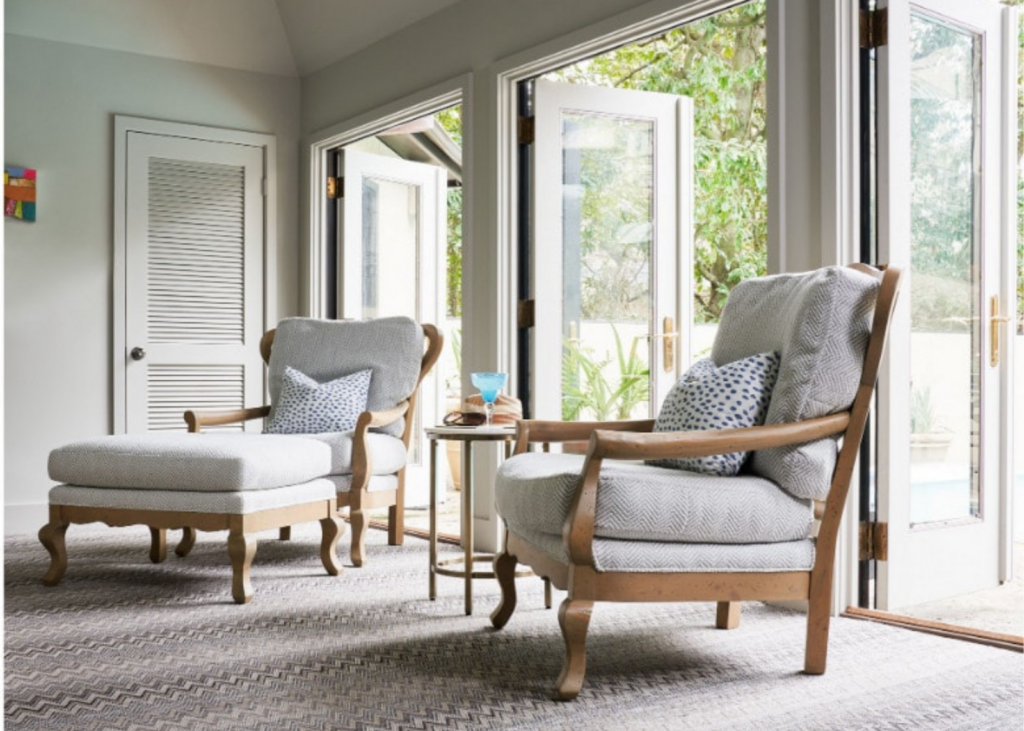
Pictured above is a photo from the Laura U Design Collective’s River Oaks Project in Houston, Texas. This image features two House and Town chairs we recovered for the River Oaks pool house.
Fourth on our list of outdoor design ideas is to reuse and refinish whenever possible. Recent surveys indicate that Americans care about sustainability more than ever before — particularly in their product consumption and in their activities at home. Senior Contributor John Cumbers underscored this point in a 2020 article for Forbes. He wrote that “despite Coronavirus, 85% of Americans are thinking about sustainability as much or more than ever.” Public knowledge of the damage fast furniture has done to our planet is growing. As such, homeowners are searching for ways to repurpose their existing home goods for the greater good.
Reviving Rusted Patio Furniture
Homeowners can reupholster comfortable patio cushions from summers past with new prints. They can also treat metal furniture that has since rusted or lost its shine by following Caroline Biggs’ advice. She offers tips in her article “How to Restore Metal Garden Furniture” for MarthaStewart.com.
Biggs writes that “your old metal garden furniture is teeming with restoration potential, it just takes a little work.” Speaking with Jane Henry of antique furniture restoration studio Jane Henry Studios, Biggs recommends considering structural integrity before reviving old furniture.
Once you have ensured the integrity and safety of your chair or stool, Henry suggests scraping away loose paint and rust. Next, prime, paint, add a protective coat and commit to regular maintenance. Of course, her advice only applies to everyday furniture — not beloved antiques or vintage pieces. Such furniture should be taken to a proper shop where professionals can treat the damage.
Bringing Indoor Furniture Outside
Not only can you refinish old metal furniture intended for the outdoors. You can also repurpose indoor furniture — like dining chairs, end tables and more — for your outdoor living area. To help your indoor furniture withstand the outdoor elements, you might need to refinish that furniture with a weather-resistant sealant, paint or stain. You might also wish to replace cushions — or cover them — with performance fabrics. (We explain how to choose weather-resistant fabrics in greater detail below.)
In a recent article for MarthaStewart.com, Kier Holmes explains how to treat and transform indoor furniture for outdoor use. If hoping to turn your indoor dining table into an outdoor dining table, Holmes recommends a polyurethane sealant. According to Holmes, polyurethane sealants are best “for light-toned wood as modern day polyurethane won’t yellow.” Should you choose to change the stain on your table or chairs, be sure to sand the furniture before applying. If you want to repaint furniture for your outdoor living room, opt for a UV-resistant finish. For lounge chairs and sofas, you can either replace, cover or spray existing fabric. Holmes suggests spraying both sides of each cushion with a “waterproofing spray.”
#5 Opt for Comfortable Yet Weather-Resistant Fabrics When Designing Outdoors
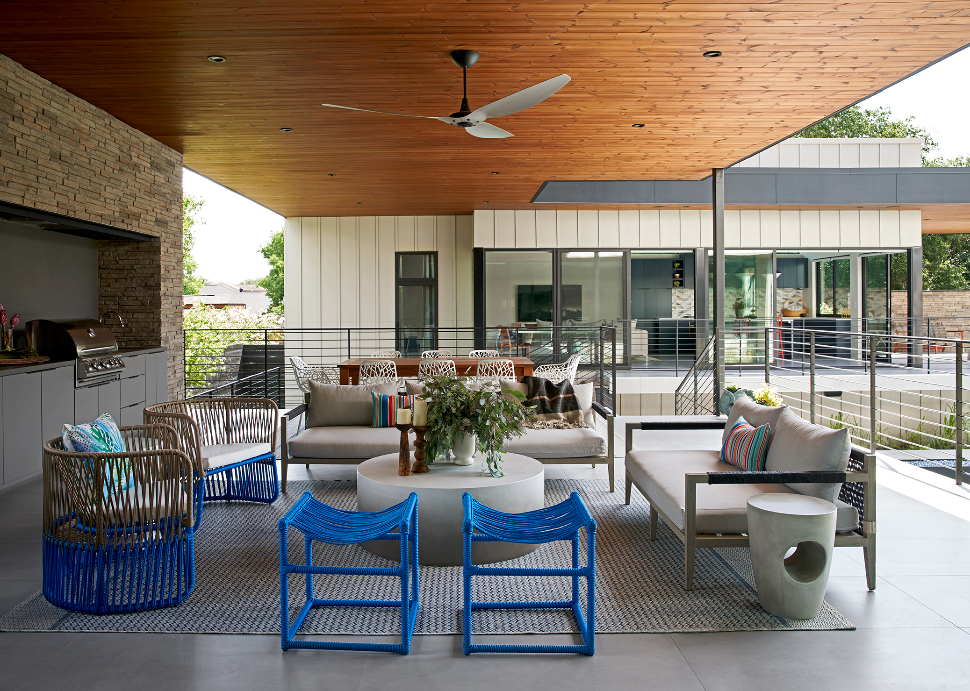
Fifth on our list of outdoor design ideas is to choose comfortable yet weather-resistant fabrics in outdoor and transitional spaces. Gone are the days of faded plastic Adirondack chairs and sticky plastic cushions. In their article “13 of the Best Outdoor Fabrics” for House Beautiful, Carisha Swanson and Brittney Morgan offer their suggestions.
They write that “today’s outdoor fabrics range from hard-wearing linens to shockingly lush chenilles and velvets” and are far from monotone. Though some are ideal for salty summer air off the coast of New England, others are better suited to dry heat. Morgan and Swanson recommend that before you choose a fabric, you “make sure you know what you’re looking for.” Also consider “how your chosen fabric will fare over time.”
In our recent Braeswood Place project, we chose performance fabrics for both the patio furniture and furniture throughout the pool house. Since guests will retreat to the pool house after swimming, performance fabrics are needed in both spaces. Above, you can see the Braeswood Place patio in the foreground and pool house in the background.
Exceptional Weather-Resistant Fabrics for Patio Furniture
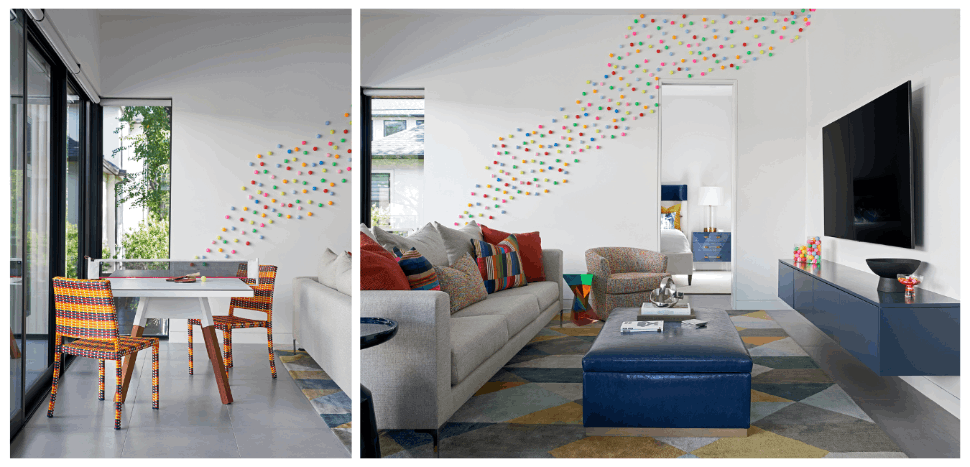
When choosing fabrics for patio furniture, durability is key. From UV exposure to consistent use, patio furniture must stand up to it all. Before buying, Swanson and Morgan suggest checking reviews and opting for fabrics marketed towards “outdoor” use rather than “performance.” They explain that “for outdoor furniture and textiles…you’re better off going with an actual outdoor fabric, not a performance option.” This is especially true of “things that will stay outside and face inclement weather.”
Next, homeowners should check each textile’s color-fastness to determine how quickly it will fade in the sun. If your home is located in a humid region — or comes equipped with a pool — be sure to consider mold and mildew-resistant fabrics. In her article “A Guide to Buying Outdoor Fabric for Cushions and Pillows” for The Spruce, Lisa Hallett Taylor elaborates. She writes that outdoor fabrics “made with a protective coating…should make the cushion or pillow repel or resist water, moisture, mold, and mildew.” Sunbrella’s fabrics — pictured above — are some of our favorites. The Laura U Design Collective team reupholstered a pair of House and Town chairs with fabric by Sunbrella for a recent River Oaks project.
#6 Remember that Small Spaces Can Have Big Impacts
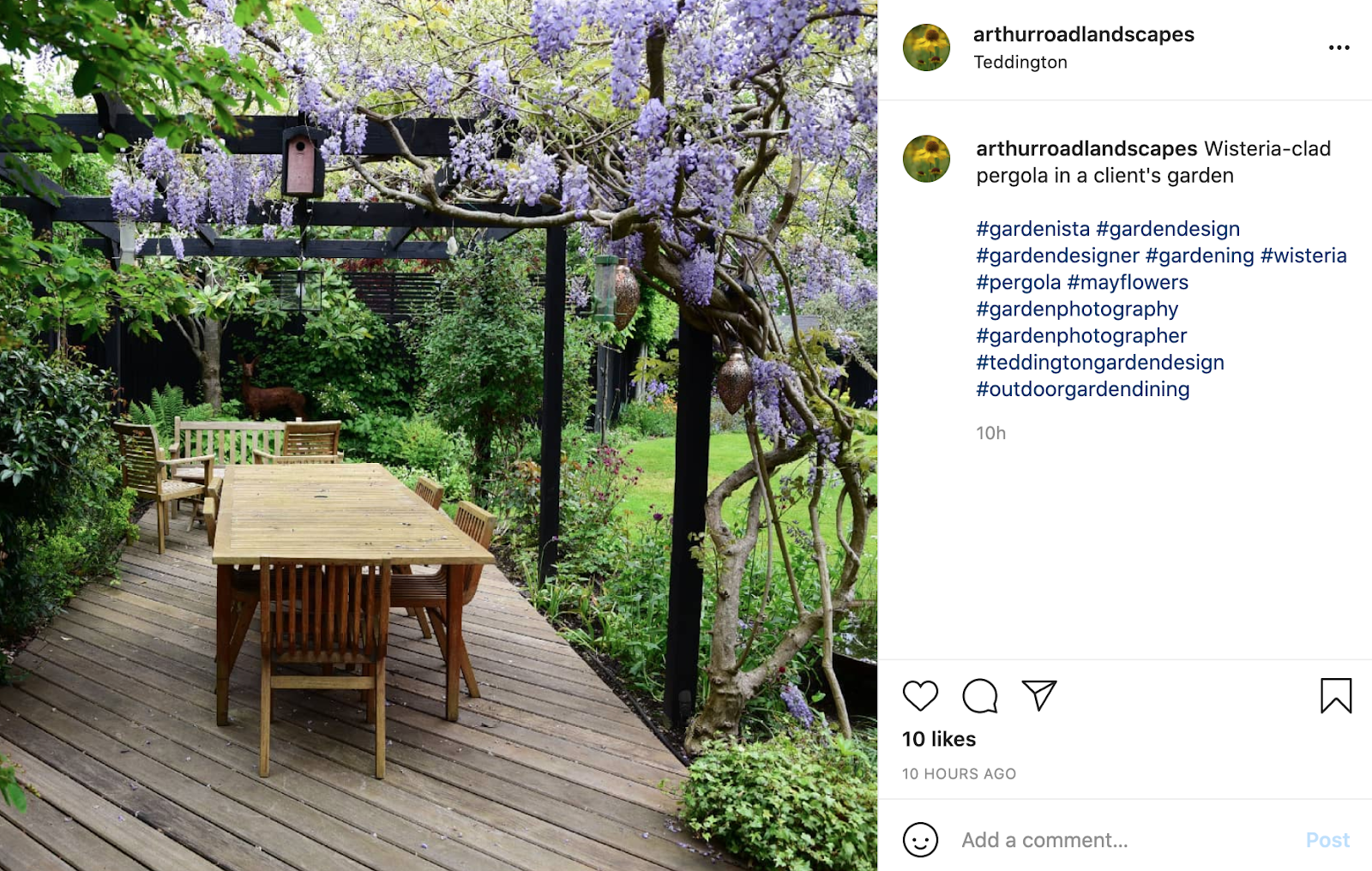
The average patio measures just over 280 square feet. As such, small-space solutions are a must for many American homeowners. In her article “14 Clever Tricks to Make Your Small Backyard Live Large” for Better Homes & Gardens, Jessica Bennett offers her advice. First, Bennett recommends investing in “multi-functional furniture [that] can help you maximize every inch of a small backyard.” Her favorites include L-shaped benches and a collection of garden stools.
Next, consider framing your space. Use an awning, canopy or gazebo to create an “intimate atmosphere” in your small backyard. Bennett writes that “these outdoor structures add shade and privacy [while offering] the comforts of an indoor room.” Lastly, consider landscaping that works well in small spaces. Opt for “plants that grow at least 2-3 feet tall and arrange them to block the view from neighbors or the street.”
#7 Never Neglect Outdoor Lighting
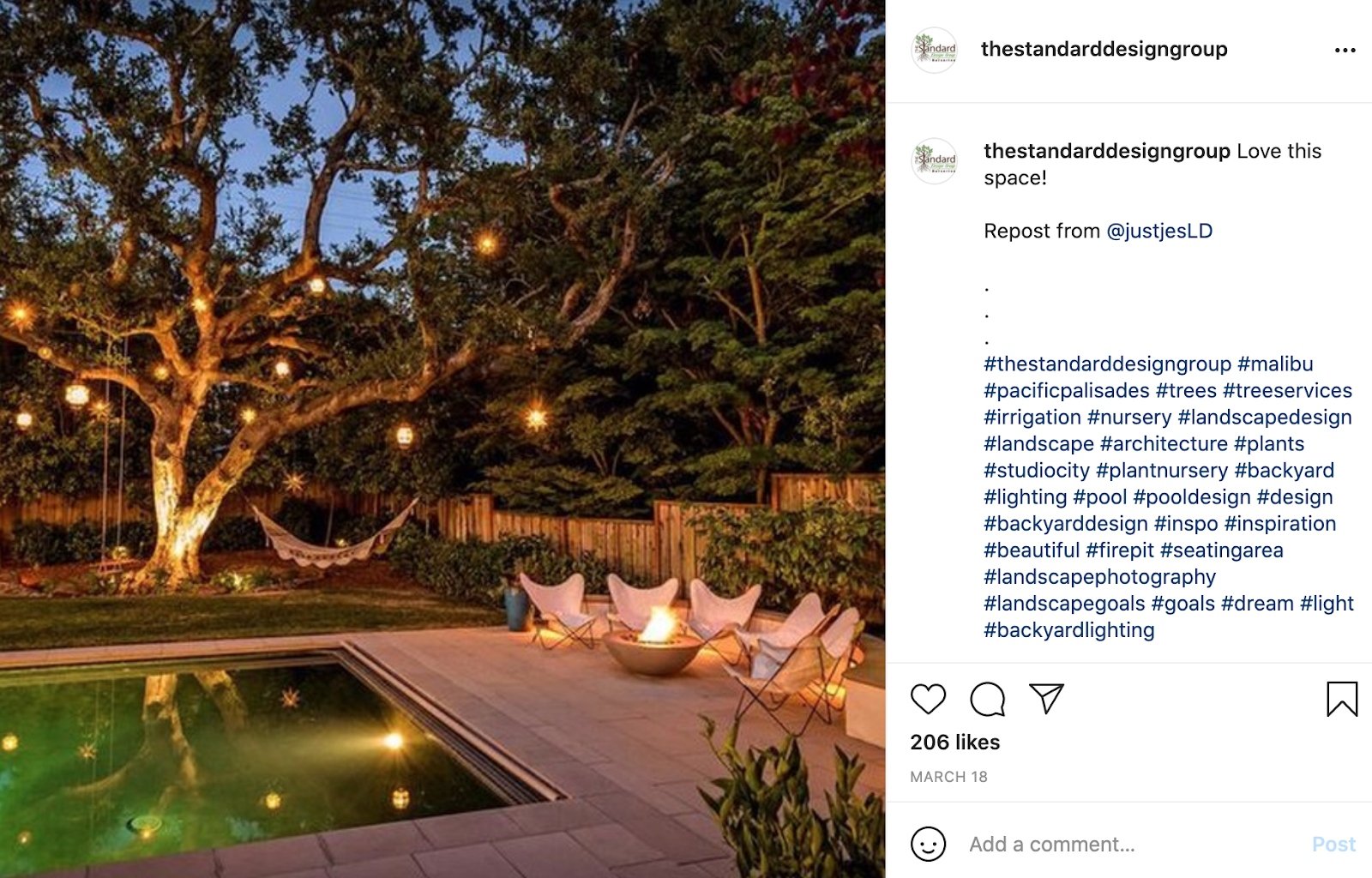
Lighting not only provides atmosphere for romantic summer evenings but also takes you from day to night and from season to season. In her article “Stylish Outdoor Lighting” for Architectural Digest, Hannah Martin recommends a series of lanterns, sconces and outdoor pendant lights. She writes that “lighting really can make a room [and] the same rule applies when you’re decorating a terrace, deck, or patio.” For a terrace, Martin suggests “flanking a door or window with classic, wall-mounted lanterns.”
If your home boasts a covered patio, consider hanging “a trio of pendant lights or one statement-making chandelier.” In a backyard without any overhangs, “punctuate an exterior wall with flush mounts.” For a fun evening filled with light and laughter, Linda Checar of Dengarden recommends string lights. She writes that “vintage string lights give your outdoor scene a party atmosphere” and instantly “brighten the evening festivities.”
#8 Design for Year-Round Use
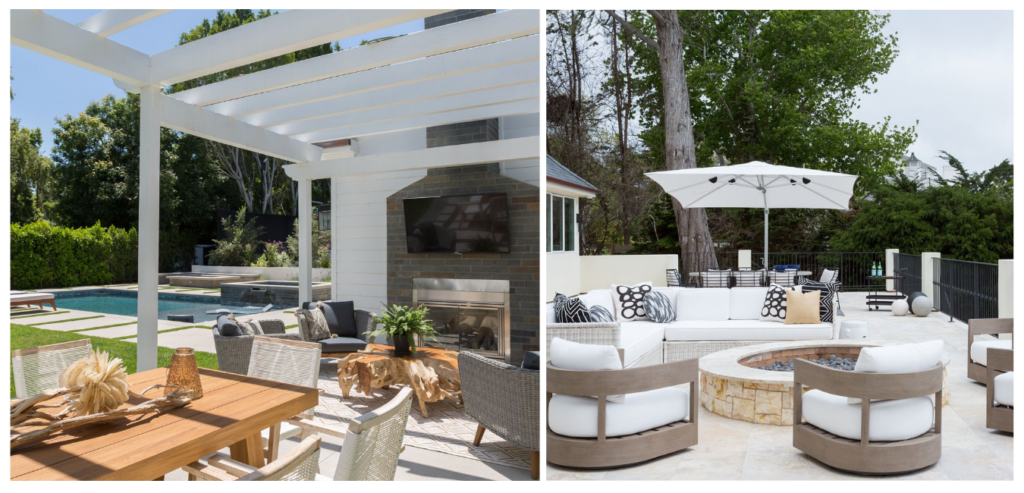
As mentioned above, outdoor spaces should be usable all year round. From landscaping that changes with the seasons, flexible options are key. In her article “10 Ways to Enjoy Your Outdoor Living Space All Year” for The Spruce, Lisa Hallett Taylor offers a few tips. First, Taylor recommends homeowners augment their entertainment area with an outdoor fireplace. She writes that “besides warming up cold guests, a fire is a nice place to gather around.”
Fireplaces are just as functional on cool Summer nights as they are during chilly Winter days. Next, homeowners should consider investing in a grill or outdoor kitchen. Taylor notes that homeowners can “continue grilling past summer” by switching up their menu, bundling their guests and adding a cozy heat lamp.
If you need help converting your seasonal outdoor space to one that can be used all year long, consider hiring a landscape architect. Landscape architects can help you create a cohesive space that blends indoor-outdoor spaces while upgrading the efficiency and sustainability of your garden. Learn more in our post “5 BENEFITS OF WORKING WITH A LANDSCAPE DESIGNER.”
#9 Keep Kids in Mind
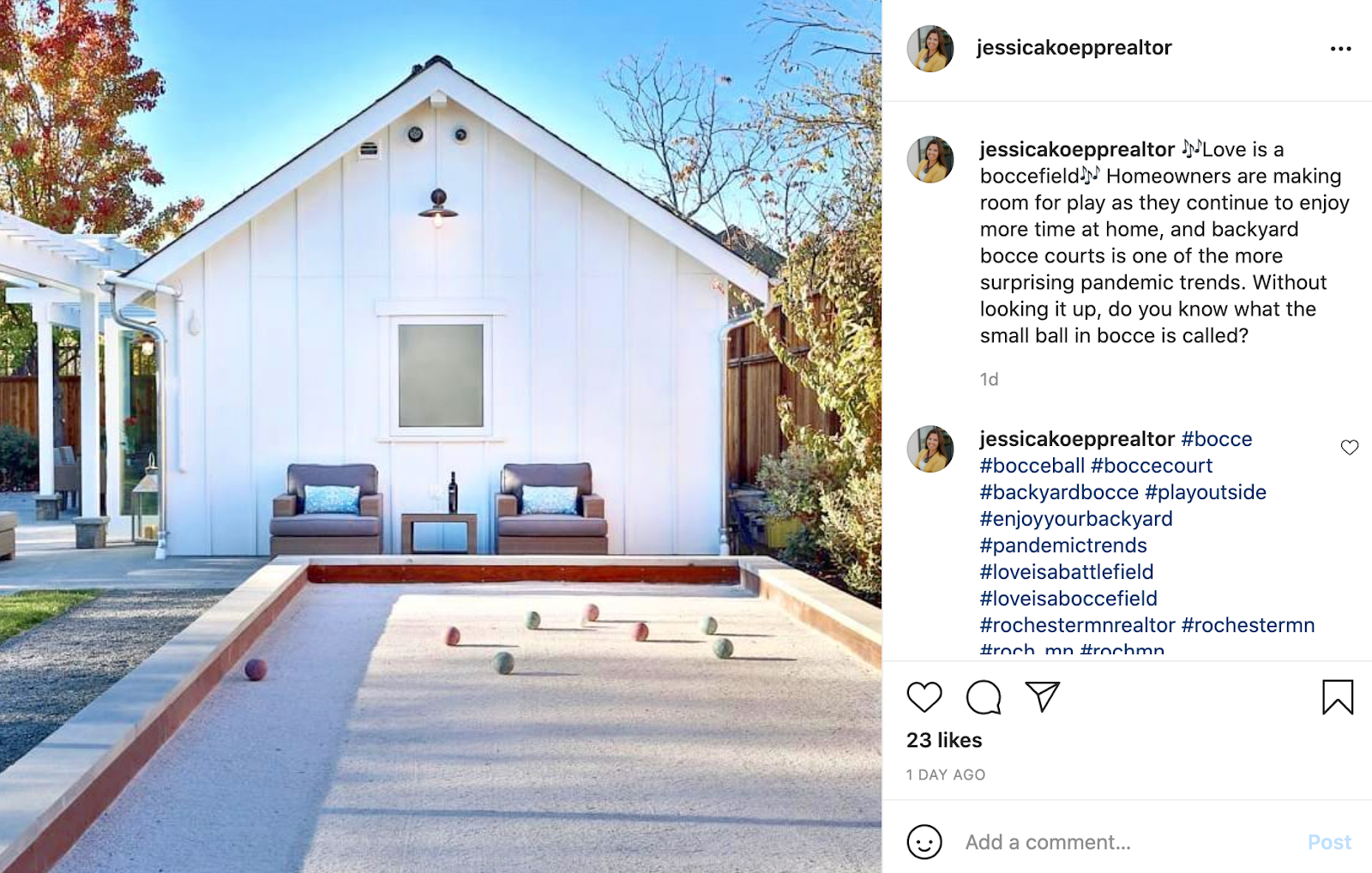
Kids are important guests in any household, but they are especially welcome during the Summer months. After all, the warm, star-filled evenings of Summer were some of the best moments of our childhoods! Thankfully, backyards and patios can function just as well for adults while also entertaining children. In her article “13 Steps to a Kid-Friendly Garden Adults Will Love Too” for Houzz, Amanda Pollard elaborates.
The first step on Pollard’s list is to keep the yard natural. She writes that “there’s often no need to buy specific items for kids to play with.” Instead, homeowners should use their “imagination and create simple play areas out of natural materials.” Next, add quirky paths and “create a sensory garden.” Consider fun furniture like egg chairs and swings and allow children to design their own spaces when they arrive.
#10 Embrace the History of Your Home
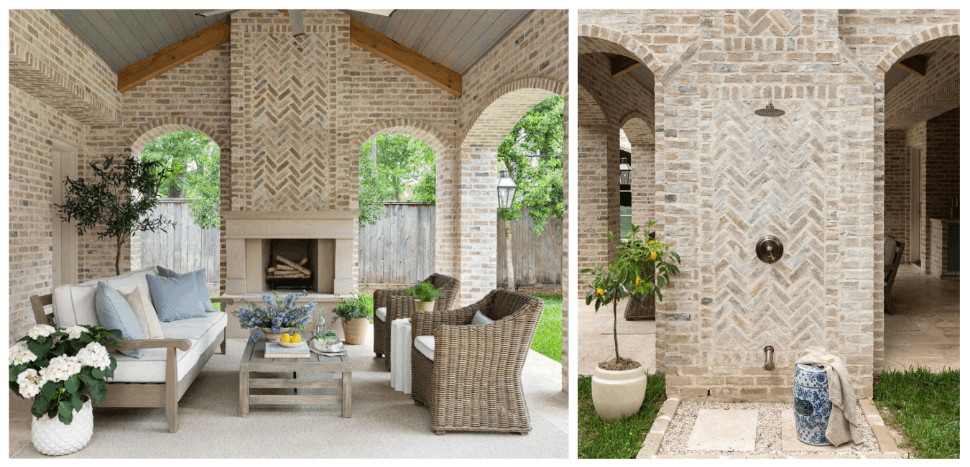
Tenth on our list of outdoor design ideas is to embrace the history of your home. If your home has lots of vintage or antique appeal, opting for a contemporary design scheme in your own backyard might not work. In our recent post about timeless interior design and architecture, we noted that “following trends…can come off tacky and insincere.”
Respecting your home’s history — on the other hand — “provides continuity — even as you add modern elements.” If you plan to remodel rather than building a new custom home, be sure to honor your home’s architectural details when designing outdoors.
Honoring History at Hedwig Village
Honoring the home’s history was a primary focus of our recent Hedwig Village project. We modernized the home’s exterior while honoring the history of their 1920s property. Our team also retained many original features within the home and carried its antique visual interest outdoors.
For example, we matched the loggia beams to those within the home for even more continuity. Arches, white-washed brick and gas lanterns tie the space to the rest of the home’s exterior and to its interior. Instead of a fire pit, we opted for a different fire feature.
We chose to install an integrated fireplace across from the seating area. This simple outdoor design idea makes the outdoor living space feel cozier and more elevated. Both stylistically and functionally, the loggia perfectly bridges the gap between the home’s interior and its outdoor living space.
Our Tips
In your own backyard, you might consider a wrought iron chandelier to match indoor elements. You might also consider custom cushions or outdoor rugs in an antique print. Landscape architecture that reflects your home’s history is another excellent choice — though a more expensive undertaking. Classic landscaping — such as climbing roses or a sprawling garden — can also root your home in its unique history without costing too much.
#11 Supplement Your Outdoor Kitchen or Dining Room with a Vegetable Garden
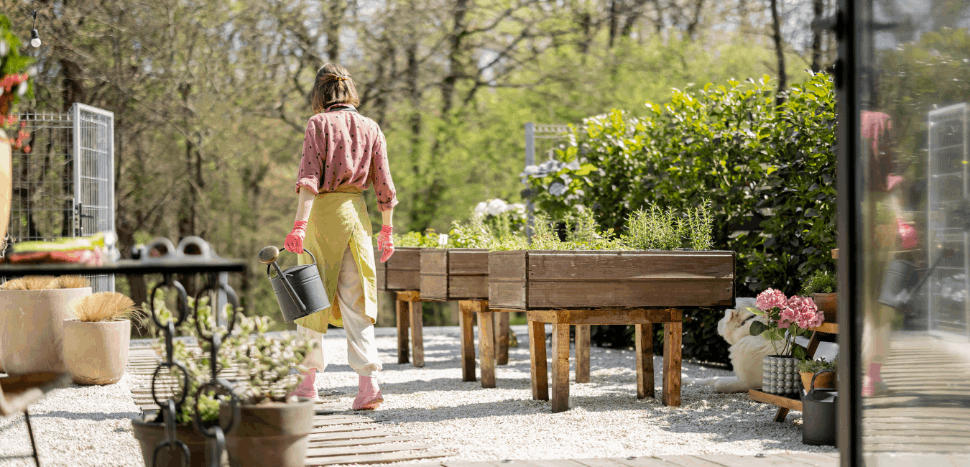
Last on our list of outdoor design ideas is to supplement your outdoor kitchen or dining room with a seasonal vegetable garden. Adding an herb garden for cocktails is another fabulous idea for outdoor bars. If you lack a green thumb, consult with a local specialist — like a landscape designer or master gardener.
By following these eleven outdoor decorating tips, your outdoor space is sure to wow this season!


